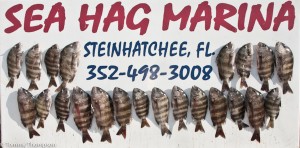Florida’s Big Bend is Famous For Sheepshead
If you’re looking for sheepshead, the Big Bend is the place to be. Cold winter waters drive the spawning rituals of these tasty fish and the big females gather over reefs, rockpiles and other structures off the Levy, Dixie and Taylor county coastlines. The best bait for these great-tasting fish is either live shrimp or fiddler crabs, presented with medium-weight tackle and jig heads or ‘knocker” rigs. These are not the smaller version of the species found inshore during the rest of the year, but big females that often reach 8 or 9 pounds. However, these fish are difficult to clean and we advise against taking a full limit of 15 fish. Cleaning that many can be a chore!
Here are some good sheepshead spots, recommended by Russ Roy and Sanford Boye of the Gainesville Offshore Fishing Club:
Cedar Key
- Steel Tower (N28 58.525 W083 09.241)
- GOFC Artificial Reef #2
This spot now sees a lot of pressure but the sheepshead are still there. The water is 15-20ft deep with downed debris running to the North of the existing tower.
Patch 1 (N28 58.930 W083 11.937) Patch 2 (N28 58.957 W083 11.962)
There are many rubble piles at the site, most of which hold sheepshead. You will find more structure if you work the area while looking at your depth finder. Also the sheepshead move around between the piles so if you are not directly on top of one you might still find that the fishing will be good.
Suwannee
- Hedemon Reef (N29 17.074 W83 15.543)
- Dixie County Reefs (N29 19.232 W83 22.050)
- Horseshoe Beach Reefs (N29 19.809 W83 26.200)
- Reef H (N29 18.436 W83 30.160)
A large shallow sandy patch with some weed areas. This used to be marked with a large concrete piling, but this has been knocked down by storms. The fish will be scattered over the reef, and very spooky during low tides due to the shallow water. Anchor up and get some bait in the water to attract them.
There are a number of reef patches in this area. The best way to check this permitted area out is to go on a calm day with good water clarity so you can see the piles on the bottom. Take numbers on all you can find. Slow cruising using your bottom finder to spot the piles, and the sheepshead, is another way. Water is about 22 ft deep.
There are about 200 tons of concrete blocks, limestone rock and railroad ties scattered in this area which is about 25 feet deep. The technique above is a good one to use here as well. During sheepshead season on a good weather weekend, both of these areas will have lots of boats on them.
This is one of the “Lindberg” reefs, named after Bill Lindberg, a researcher at U. Florida Fisheries Dept, to study whether or not artificial reefs would encourage more reef fish, especially grouper. This reef is made of patches of 16 large concrete cubes laid out at the points of a hexagon. Water here is about 40 feet deep and some of the patches typically hold more sheepshead than the others.
Steinhatchee
- Steinhatchee Artificial Reef (N29 39.480 W83 37.490)
This is a reasonable large artificial reef that is very good for sheepshead. Just look for the boats as you approach the number as it is very popular.


